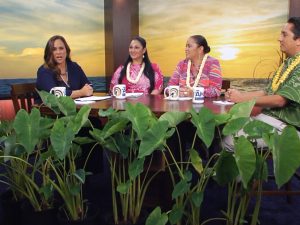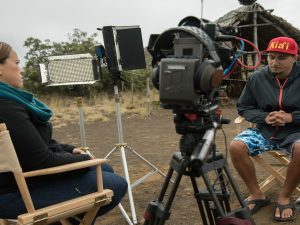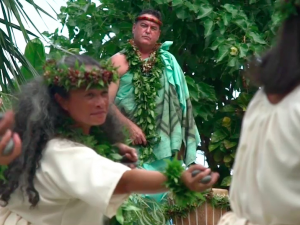Ma hope o ke kanakolu a ʻoi makahiki o ke kōkua ma ka hoʻokele ʻana i kekahi o nā aukahi hoʻōla ʻōlelo ʻōiwi ikaika loa a puni ka honua, ua paʻa maila he home no ke koleke ʻo Ka Haka ʻUla ʻO Keʻelikōlani, ʻo Haleʻōlelo nō ia.
After 30 years of leading one of the strongest language movements ever, the Hawaiian Language College has its own home, Haleʻōlelo.
[spb_tabs width=”1/1″ el_position=”first last”] [spb_tab title=”ʻŌlelo Hawaiʻi”]Ma hope o ke kanakolu a ʻoi makahiki o ke kōkua ma ka hoʻokele ʻana i kekahi o nā aukahi hoʻōla ʻōlelo ʻōiwi ikaika loa a puni ka honua, ua paʻa maila he home no ke koleke ʻo Ka Haka ʻUla ʻO Keʻelikōlani, ʻo Haleʻōlelo nō ia.
“Kēia Haleʻōlelo nei, he inoa hoʻomanaʻo nō hoʻi i ke aliʻi Keʻelikōlani,” wahi a Hiapo Perreira, he Hope Polopeka hoʻi ma Ka Haka ʻUla ʻO Keʻelikōlani. “Ke kumu hoʻi a Keʻelikōlani i kapa aku ai i kona hale, ʻo Haleʻōlelo, no ka mea, no loko mai o kona kauhale, e pua ai ka ʻōlelo, hahai kānaka. Kēia kapa ʻana i kēia hale nei, ʻo Haleʻōlelo, ʻaʻole he pili i kēia wahi wale nō, ʻaʻole i pili i kēia mau kānaka wale nō, ʻaʻole he pili iā kākou wale nō, i hoʻi ka mana o ka ʻōlelo Hawaiʻi, ʻo ia ke aliʻi.”
A i mea e kō maoli ai kēlā, pono e laha a lohe ʻia ka ʻōlelo ma nā ʻano wahi like ʻole e ʻōlelo ʻia nei e nā ʻano kānaka like ʻole. A i loko o kēia mau makahiki kanakolu i hala iho nei, ua nui nō ka holomua.
“I loko o kēlā ʻimi ʻana a hoʻokō a piha ka papahana mai nā pēpē Hiʻipēpē, kēlā pae a hiki loa aku i ke kauka, ʻeā, me ka loaʻa ʻole o ka hale, ua nui ke kō,” wahi a Keiki Kawaiʻaeʻa, ka Luna Hoʻokele hoʻi o Ka Haka ʻUla ʻO Keʻelikōlani. “Ua ulu ke aukahi hoʻōla ʻōlelo Hawaiʻi me ka loaʻa ʻole o kekahi hale. Eia nō naʻe, ke kū nei ka hale i kēia manawa.”
He hale piha a paʻa pono. Piha i nā lako e pono ai, nā ʻano lumi like ʻole e pono ai, a me ka ʻohana kūpaʻa i ka ʻōlelo e ola maoli ai ko kēia hale nei.
“No kēlā mau poʻe a pau ma Hawaiʻi nei i kākoʻo mai ma ka ʻimi ʻana i ke kālā, ke kākoʻo mai ma ke kūkulu ʻana i ka papahana, nā mākua i kūpaʻa a hoʻoholo a laila kūpaʻa no nā makahiki he lōʻihi, a me nā kūpuna i kū ma ko kākou ʻaoʻao,” wahi a Keiki.
“Iā Matthews mā, iā Kanakaʻole mā, iā Makuakāne mā, iā Kealoha mā, iā Kaʻilianu mā, a ia mau kūpuna aku, ia mau kūpuna aku, ʻo kēlā nō wā o nā makahiki hoʻomaka, he piko kēia, he honua kekahi e hui pū nei me nā honua ʻē aʻe a pau o Hawaiʻi nui ākea a puni, e hoʻi hou ai ka mana o kā kākou ʻōlelo kūpuna i ka niʻo ma kona ʻāina kūpuna iho nō,” wahi a Hiapo. “A ke hea aku nei wau iā ʻoukou e paia mā e paʻa maikaʻi ʻoukou a no ka mea, i loko o ko ʻoukou mau alo, kahi e lawelawe nui ʻia ai ka hana i loko nei. No kā kākou mau keiki kēia hale, no kā kākou poʻe moʻopuna a mau loa aku nō kēia wahi e kū mai a mau. He kia hoʻomanaʻo no ke ola o kā kākou ʻōlelo Hawaiʻi.”
A ua ʻike ʻia nō ka hua o kā Hiapo e ʻōlelo nei ma o ke keiki Pūnana Leo, nāna i pani i ka Hoʻolaʻa Hale o Haleʻōlelo.
“ʻO Kahaʻiʻōlelo Helm koʻu inoa, ʻehā oʻu makahiki, noho wau ma ʻŌlaʻa. ʻO Malcom me Kapua koʻu mau mākua. E komo mai i loko o ka hale!”
[/spb_tab] [spb_tab title=”English”]After 30 years of leading one of the strongest language movements ever, the Hawaiian Language College has its own home, Haleʻōlelo.
“It is a name that honors the College’s namesake, Chiefess Ruth Keʻelikōlani,” says Hiapo Perreira, who is the Assistant Professor at Ka Haka ʻUla ʻO Keʻelikōlani. “It was from this “hale” that significant “ʻōlelo” or proclamations were decreed to her people. Naming our hale “Haleʻōlelo” is not just about this place, or those of us here, it is about returning that status to our language, as if an aliʻi.”
Our ʻōlelo must therefore be heard everywhere, spoken by all ages and we’ve seen this happening for 30 years.
“An entire Hawaiian medium educational system has been established from an infant-toddler program all the way to the Ph.D. level,” says Keiki Kawaiʻaeʻa, who is the Director at Ka Haka ʻUla ʻO Keʻelikōlani. “And while we grew this movement without a hale of our own, we do have one today.”
An impressive structure, complete with the necessary ammenities, various meeting and teaching spaces, that will be a home for those ensuring our ʻōlelo contineus to thrive.
“This ʻohana includes those who helped secure the resources to build this program, thos efamilies who have been involved from the start, and the steadfast elders who stood with us all along,” says Keiki.
“Matthews, Kanakaʻole, Makuakāne, Kealoha, Kaʻilinanu and all the kūpuna that were with us from the beginning. This is a place where all of us can work together on returning our ʻōlelo to the status it deserves in its homeland,” says Hiapo. “I call out to you, the walls of this hale, to stand firm in support of the significant work that will take place before you. This hale will stand for generations to come as a testament to our living Hawaiian language.”
And Hiapo’s words were solidified by a Pūnana Leo student, whose voice concluded the opening ceremony of Haleʻōlelo and welcomed the future of his ʻōlelo Hawaiʻi.
“My name is Kahaʻiʻōlelo Helm. I am four years old and am from ʻŌlaʻa. My parents are Malcom and Kapua. Welcome to Haleʻōlelo.”
[/spb_tab] [/spb_tabs]



